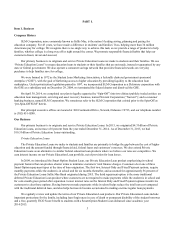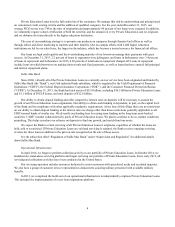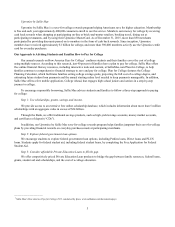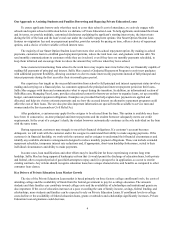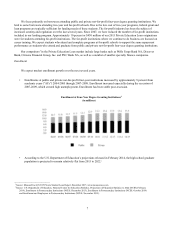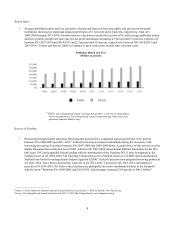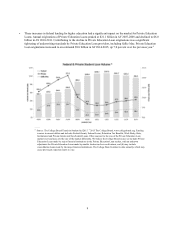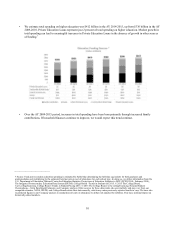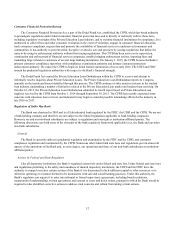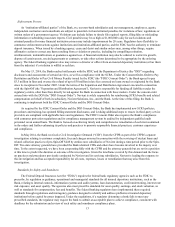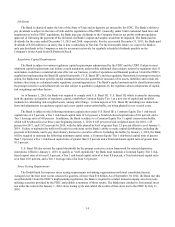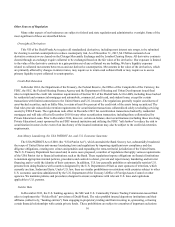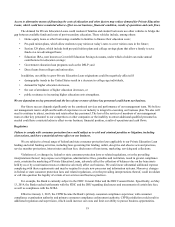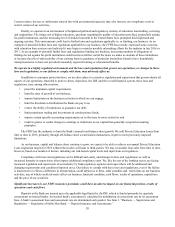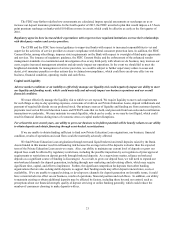Sallie Mae 2015 Annual Report Download - page 15
Download and view the complete annual report
Please find page 15 of the 2015 Sallie Mae annual report below. You can navigate through the pages in the report by either clicking on the pages listed below, or by using the keyword search tool below to find specific information within the annual report.13
Enforcement Powers
As “institution-affiliated parties” of the Bank, we, our non-bank subsidiaries and our management, employees, agents,
independent contractors and consultants are subject to potential civil and criminal penalties for violations of law, regulations or
written orders of a government agency. Violations can include failure to timely file required reports, filing false or misleading
information or submitting inaccurate reports. Civil penalties may be as high as $1,000,000 a day for such violations and
criminal penalties for some financial institution crimes may include imprisonment for 20 years. Regulators have flexibility to
commence enforcement actions against institutions and institution-affiliated parties, and the FDIC has the authority to terminate
deposit insurance. When issued by a banking agency, cease and desist and similar orders may, among other things, require
affirmative action to correct any harm resulting from a violation or practice, including by compelling restitution,
reimbursement, indemnifications or guarantees against loss. A financial institution may also be ordered to restrict its growth,
dispose of certain assets, rescind agreements or contracts, or take other actions determined to be appropriate by the ordering
agency. The federal banking regulators also may remove a director or officer from an insured depository institution (or bar them
from the industry) if a violation is willful or reckless.
On May 13, 2014, the Bank reached settlements with the FDIC and the Department of Justice (the "DOJ") regarding
disclosures and assessments of certain late fees, as well as compliance with the SCRA. Under the Consent Order, Order to Pay
Restitution and Order to Pay Civil Money Penalty issued by the FDIC (the "FDIC Consent Order"), the Bank agreed to pay
$3.3 million in fines and oversee the refund of up to $30 million in late fees assessed on loans owned or originated by the Bank
since its inception in November 2005. Under the terms of the Separation and Distribution Agreement executed in connection
with the Spin-Off (the "Separation and Distribution Agreement"), Navient is responsible for funding all liabilities under the
regulatory orders, other than fines directly levied against the Bank in connection with these matters. Under the consent order
entered into with the DOJ (the "DOJ Consent Order"), Navient is solely responsible for reimbursing SCRA benefits and related
compensation on behalf of both its subsidiary, Navient Solutions, Inc., and the Bank. At the time of this filing, the Bank is
continuing to implement both the FDIC Consent Order and the DOJ Consent Order.
As required by the FDIC Consent Order and the DOJ Consent Order, the Bank has implemented new SCRA policies,
procedures and training, has updated billing statement disclosures, and is taking additional steps to ensure its third-party service
providers are compliant with applicable laws and regulations. The FDIC Consent Order also requires the Bank’s compliance
with consumer protection regulations and its compliance management system be audited by independent qualified audit
personnel on an annual basis. The Bank is focused on achieving timely and comprehensive remediation of each item contained
in the orders and further enhancing its policies and practices to promote responsible financial practices, customer experience
and compliance.
In May 2014, the Bank received a Civil Investigative Demand (“CID”) from the CFPB as part of the CFPB’s separate
investigation relating to customer complaints, fees and charges assessed in connection with the servicing of student loans and
related collection practices of pre-Spin-Off SLM by entities now subsidiaries of Navient during a time period prior to the Spin-
Off. Two state attorney generals have provided the Bank identical CIDs and others have become involved in the inquiry over
time. To the extent requested, we have been cooperating fully with the CFPB and the attorney generals but are not in a position
at this time to predict the duration or outcome of the investigation. Given the timeframe covered by this demand and the focus
on practices and procedures previously conducted by Navient and its servicing subsidiaries, Navient is leading the response to
this investigation and has accepted responsibility for all costs, expenses, losses or remediation that may arise from this
investigation.
Standards for Safety and Soundness
The Federal Deposit Insurance Act (the “FDIA”) requires the federal bank regulatory agencies such as the FDIC to
prescribe, by regulation or guidance, operational and managerial standards for all insured depository institutions, such as the
Bank, relating to internal controls, information systems and audit systems, loan documentation, credit underwriting, interest rate
risk exposure, and asset quality. The agencies also must prescribe standards for asset quality, earnings, and stock valuation, as
well as standards for compensation, fees and benefits. The federal banking regulators have implemented these required
standards through regulations and interagency guidance designed to identify and address problems at insured depository
institutions before capital becomes impaired. Under the regulations, if a regulator determines a bank fails to meet any
prescribed standards, the regulator may require the bank to submit an acceptable plan to achieve compliance, consistent with
deadlines for the submission and review of such safety and soundness compliance plans.


